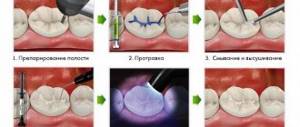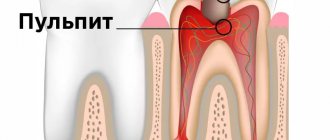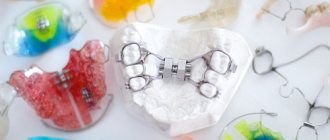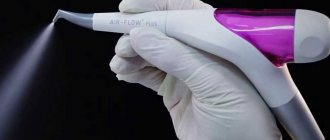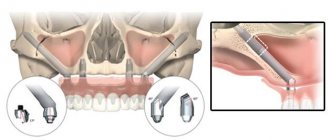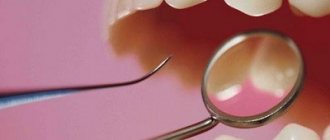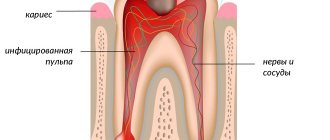In 1912, the German doctor Albert proposed a new method for treating infected tooth canals, which involved the use of resorcinol-formalin paste. It was believed that the latter has bactericidal and mummifying properties that can stop the decay of the pulp. This made it possible to seal and clean the dental canal from pathogenic microflora.
Factors influencing the popularity of the method
This method of root canal filling has gained wide popularity due to its low cost. In the territory of the former USSR, it was actively used for the treatment of chewing teeth. Factors that influenced the popularity of this method were as follows:
- the doctors were absolutely convinced that the composition of resorcinol-formalin paste was reliable and safe;
- the simplicity of the procedure, even specialists with little experience took on it;
- obtaining the desired result with a minimal set of manipulations;
- public availability.
Side effects
Just like phenol, resorcinol formaldehyde, if used incorrectly, can cause a number of undesirable reactions from the body. The most common effects that occur are:
- nausea;
- vomit;
- severe headaches;
- dizziness;
- increased sweating;
- cyanosis;
- increased heart rate;
- spasms and cramps;
- loss of consciousness.
In rare cases, after taking Resorcinol formaldehyde, allergic reactions such as dermatitis, itching and redness of the skin, urticaria, bronchospasm and angioedema may develop.
Resorcinol-formalin method: preparatory stage
The essence of this method is to transform the pulp into a plastic-like aseptic strand, which would not be subject to dissolution under the influence of tissue microflora. Therefore, in order to avoid the development of “residual pulpitis,” the pulp must be devitalized before impregnation begins.
Filling canals using Albrecht technology is carried out in several stages. At the preparatory stage, attention is paid to filling the root canals, which were managed to pass along the entire length. Others are filled in to the extent possible. Then, to necrotize the tissue remnants of the damaged pulp, the mouths of each of them are drilled out. Three sessions are allotted for all manipulations.
At this stage, the specialist is preparing the solution. Start making a paste with 5 drops of formaldehyde, for which a glass plate is used. Afterwards, resorcinol is gradually added to it. Thorough stirring ensures its complete absorption by formaldehyde.
During impregnation, the patient must be placed in the dental chair in a position that would allow the impregnation solution to flow into the canal under the influence of gravity. Filling the teeth of the lower jaw requires an even fit, while a lying position with the head tilted back will be required in the case of treatment of teeth in the upper jaw.
Impregnation of channels with solution
After this, the procedure for impregnating the channels with the solution begins. How does this happen:
- saliva is isolated and the entire surface of the oral cavity is dried;
- no more than 2 drops of the substance are squeezed out from the prepared medicinal mixture using a pipette;
- using an endodontic instrument in dentistry, a solution is injected to the maximum possible depth of the canal of the affected tooth;
- if there are residual components of the substance, they are removed using a cotton swab;
- all actions are repeated three times;
- when it is not possible to penetrate directly to the mouth, a tampon pre-moistened in the treatment solution is applied to the area being treated;
- at the end, a special dentin bandage is used to tighten the orifice.
Overdose
Overdose of the drug causes weakness, lethargy and drowsiness
As a result of prolonged topical use of Resorcinol over large areas of skin, an overdose may occur. In this case, the patient may experience the following conditions:
- noise in ears;
- weakness;
- fainting;
- dizziness;
- breathing disorders;
- rapid pulse;
- convulsions;
- cyanosis.
If there is at least one of the described signs of overdose, the patient should consult a specialist. He will choose the fastest and safest method of rehabilitation, prescribing the patient to take another remedy.
Subsequent stages
The patient's next session awaits a few days later. The doctor removes the dentin bandage and re-does all the manipulations that the affected areas were subjected to during the first procedure. Thus, they are additionally impregnated with resorcinol-formalin mass.
Then the solution used is modified. A specialist adds a catalyst to it on a pre-prepared glass plate. The latter is represented by 3 drops of chloramine, in other cases - 2 drops of sodium hydroxide. The prepared mixture completely seals the affected canal. Its filling with resorcinol-formalin substance is brought to the state of a tight mass. All excess is removed. A phosphate cement liner is then used to cover the orifice. In addition to it, a permanent filling material is fixed to the dental crown, thanks to which the treated cavity is closed.
Disadvantages of the method
At the time this method was proposed, no one asked how safe it was and whether there were contraindications to its use. Gradually, certain shortcomings were discovered, which prompted doctors to resort to less dangerous methods of treating carious lesions. To date, the following disadvantages of the resorcinol-formalin method are known.
Firstly, this is a high concentration of dangerous oncogenic substances. It is known that their presence provokes the occurrence of malignant tumors in different parts of the human body. Many doctors agree that a high percentage of cancer diseases during that period was associated with such dental intervention. The excessive toxicity of the substance affected the body with other pathologies, from which it was not possible to completely recover.
Secondly, this is the penetration of the composition into the bloodstream. Its gradual spread throughout the body has a detrimental effect on the cardiovascular and muscular systems, as well as the proper functioning of the liver, lungs, kidneys and other important organs.
It was also noted that some time after the filling procedure, tooth enamel and dentin begin to acquire a pink tint. This unaesthetic effect is caused by irritation of periodontal tissue as a result of resorcinol-formalin entering the apical fissure. Even with high-quality bleaching, it will not be possible to completely get rid of it. Clinical experience shows that the so-called resorbed teeth are fused to the adjacent bone tissue.
Many difficulties arise when analyzing radiographs. The reason for this is the non-radiographic contrast of the resorcinol-formalin paste used to fill the root canals. A good specialist, having visually identified a void in the canal, will definitely recommend refilling it. But given that over time the durability of the mixture becomes comparable to the strength of glass, it will be difficult to follow the recommendations.
Instructions for use
The use of Resorcinol is indicated for a number of viral, infectious and inflammatory skin diseases. We are talking about the following pathologies:
- dermatitis;
- eczema;
- sycosis;
- seborrhea;
- mycosis;
- fungal infections;
- skin itching.
Resorcinol can be used in combination with hormones and antibiotics in the treatment of alopecia or acne.
Under the age of 12 years, taking the drug is contraindicated
Absolute contraindications to the use of this drug are:
- hypersensitivity to the components of the product;
- burns of a chemical or thermal nature;
- breastfeeding and pregnancy;
- age up to 12 years;
- deep skin damage.
Patients with sensitive skin should use Resorcinol with caution. The same applies to adolescents during a period of increased hormonal development.
An alcohol solution of Resorcinol is intended for external application to affected skin. A cotton swab is used for this. The ointment is applied at night and requires a bandage. The dosage is individual and determined depending on the specific disease.
For the treatment of diseases, the instructions for using Resorcinol are as follows:
- To remove red acne, use a 1% alcohol solution of Resorcinol.
- To treat oily seborrhea, rub a 1 or 2% alcohol solution into the scalp. Treatment of eczema and dermatitis is carried out according to the same scheme. For the treatment of seborrheic eczema, the drug can be used in combination with sulfur. This combination allows you to achieve the most pronounced effect.
- For acne vulgaris, ointment is used for exfoliation. As a rule, a composition with a 10-15 percent content of the active component is used.
- Local therapy for genital warts requires the use of pure powder, which is used as a powder.
- Due to the fact that resorcinol formalin is an excellent antiseptic, it is used in medicine not only as an independent remedy, but also as an active component of a number of drugs. For example, Resorcinol is contained in Fucocin solution and rectal suppositories, and is part of Castellani liquid and Andriasyan ointment - products that are actively used in the treatment of pyoderma and mycoses.
- To cleanse the skin of oily seborrhea, hydroalcoholic products based on boric and salicylic acids mixed with Resorcinol are used.
- This product has also found application in dentistry. Here, resorcinol-formaldehyde paste is used, through which the canals are filled as a result of incomplete extirpation of the pulp. At the moment, this composition is used quite rarely due to its toxicity.
- There are also lotions with a pronounced keratolytic effect, which include salicylic acid, resorcinol and allantoin.
The dangers of the resorcinol-formalin method
The elasticity and stability of hard tooth tissues significantly deteriorates. The combination of formaldehyde with resorcinol provokes the coagulation of proteins in tissues. As a result, dentin, which is considered a fairly hard substance, loses all its quality indicators. The patient is forced to once again seek help from a dental clinic. However, a damaged dentin structure reduces the specialist’s chances of bringing the oral cavity into an impeccable appearance. The presence of such a filling can develop hypercementosis, manifested by intensive covering of the roots with cement. When using dental instruments, it tends to crumble. Doctors note that installing a crown on such a tooth is impossible. And there is only one way out - removal of the unit followed by prosthetics.
This treatment method causes frequent inflammatory processes in the surrounding tissues. Due to drug preservation of the pulp, the patient is not aware of the presence of hidden infectious processes. Their spread affects adjacent gums and roots. Due to the toxicity of the substance used, gradual destruction of periodontal tissue begins. In addition, other foci of infection form in the form of a cyst or phlegmon. The danger lies in the asymptomatic nature of these processes.
Pharmacological properties
The solution of this drug has healing and epithelializing effects. It stimulates tissue regeneration, helping to effectively eliminate the inflammatory process. By acting on lesions, the solution manifests itself as an antiseptic and astringent.
Resorcinol is often used in cosmetology, where its cauterizing and exfoliating properties are highly valued. Used as a scrub, it allows for deep cleansing of the skin. The drug can also be successfully used for disinfection purposes.
Consequences
Scientific studies confirm that formaldehyde-containing endodontic filling materials lead to irreversible destruction of connective tissue and bone, and paresthesia of the lower jaw. Chronic infections of the maxillary sinus cannot be ruled out. Moreover, the damage from formaldehyde is not limited to tissue damage only in the root canal. The components contained in the proposed sealants tend to penetrate into the body itself.
Resorcinol-formalin paste in dentistry, the consequences of which are very dangerous and irreversible, is prohibited in most countries of the world. So, in Switzerland it was excluded more than 70 years ago. In America, a doctor who dares to offer this method to a patient risks losing his license.
Reviews
Reviews about Resorcinol are mostly positive. Here are some of them.
Olga, Saratov “Used Resorcinol in the treatment of acne vulgaris. The doctor prescribed me a 15% ointment, which I applied to the affected area twice a day. As a result, the acne began to dry out slowly and then disappeared completely. A year passed and I completely forgot about my acne problems.”
Valery, Nizhny Novgorod “A 14-year-old child was prescribed Formalin Resorcinol for eczema. They applied it several times a day - it didn’t help. In the end, the doctor suggested choosing a different medicine.”
Igor, St. Petersburg “I used Resorcinol in powder form as powders. As a result, irritation developed and the treatment had to be canceled. I do not recommend this drug to anyone.”
Maxim, St. Petersburg “Excellent product! The doctor prescribed me resorcinol alcohol to cauterize papillomas. Since there were only two, he said that a local remedy would be most effective. And I turned out to be right - I eventually got rid of papillomas once and for all!”
Resorcinol-formalin technology in Russia
Despite the fact that dental practice offers safe methods of root canal treatment, in Russia the resorcinol-formalin method continues to exist. It is mainly used by peripheral specialists, who are probably aware of its harmful effects. But the lack of funds for high-quality materials and equipment for endodontics forces them to use easily accessible means.
The indestructibility of the method is also associated with its low cost and the reluctance of citizens to pay for quality service. In 2001, the All-Russian Dental Association appealed to the Central Commission for Higher Education with a demand to exclude the resorcinol-formalin method from the curriculum of dental faculties.
Drug interactions
Before you start taking Resorcinol, you should carefully read the instructions for drug interactions with other drugs.
Formalin resorcinol is absolutely incompatible with the following drugs:
- Antipyrine.
- Camphor.
- Salicylic acid.
- Menthol.
- Phenyl salicylate phenol.
If we are talking about an alcohol solution or a powder form of the product, then it is incompatible with substances that have an alkaline reaction. In the form of an ointment, the product cannot be used together with yellow mercuric oxide, since the latter completely loses its effectiveness.
